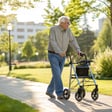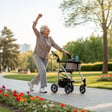Growing older doesn't mean giving up on fitness. In fact, maintaining flexibility becomes even more crucial as we age.
Why Yoga for Seniors Makes Perfect Sense
The journey past 50 brings wisdom, but it often brings stiffness too. Many of us wake up with creaky joints and muscles that seem to have forgotten how to stretch overnight. That's where gentle yoga enters the picture.
According to Johns Hopkins Medicine, "Yoga improves strength, balance and flexibility. Slow movements and deep breathing increase blood flow and warm up muscles, while holding a pose can build strength." These benefits become increasingly valuable as we age.
Unlike high-impact workouts that can stress aging joints, yoga offers a gentler approach to fitness that's particularly well-suited for those in their golden years. Senior fitness programs increasingly incorporate yoga elements because they're effective without being punishing.
Mary Williams, a 67-year-old yoga enthusiast from Portland, told me last week, "I started with just five minutes a day. Now I'm more flexible than I was at 40!"
Easy Yoga Exercises to Start Your Flexibility Journey
If you're new to over 50 workouts, these beginner yoga poses can help ease you into a regular practice:
Chair Pose with Modification
This seated variation helps build core strength while being gentle on the knees:
- Sit toward the edge of a sturdy chair
- Extend arms forward at shoulder height
- Engage your core as you breathe deeply
- Hold for 3-5 breaths
Don't worry about perfect form initially—focus on how your body feels instead.
Gentle Spinal Twist
This move helps maintain spine mobility:
- Sit sideways on a chair
- Turn your upper body toward the chair back
- Use the chair for support as you gently twist
- Hold for 30 seconds, then switch sides
"Spinal flexibility is crucial for everyday movement," notes Emma Mitchell, a physiotherapist at Bupa Health. "Simple twists can help reduce back pain and improve overall mobility."
Safe Yoga Moves for Joint Protection
For those with arthritis or joint concerns, these modifications offer the benefits of yoga without the strain:
Modified Downward Dog
Traditional downward dog can be challenging for wrists and shoulders. Try this instead:
- Use a wall for support, placing hands at waist height
- Step back until your body forms a diagonal line
- Keep knees slightly bent to protect your lower back
- Hold for 5-8 breaths
Seated Forward Fold
This stretching yoga pose targets hamstrings without stressing the back:
- Sit on the edge of a chair
- Extend one leg, keeping a slight bend in the knee
- Hinge forward from the hips
- Hold for 30 seconds per side
The NHS physical activity guidelines recommend that older adults "do activities that improve strength, balance and flexibility on at least 2 days a week." These gentle modifications make that goal achievable.
How Often Should You Practice Yoga Poses for Flexibility?
Consistency trumps intensity when it comes to improving flexibility after 50.
"I tell my clients to aim for 10-15 minutes daily rather than an hour once a week," says Thomas Rivera, a yoga instructor specializing in senior classes. "Short, regular sessions yield better results than occasional marathon practices."
The Mayo Clinic supports this approach, noting that "stretching can increase flexibility and improve the range of motion in your joints. Being more flexible can help you move more freely."
Start with three 10-minute sessions weekly, gradually building to daily practice as your body adapts.
What About Hot Yoga for Seniors?
While trendy, hot yoga isn't typically recommended as the best approach for seniors. The extreme heat can tax the cardiovascular system and increase dehydration risk.
Thermal Horizons Yoga Studio offers specific guidance: "Consult with your healthcare provider before beginning any new exercise program." This is particularly important for heated classes.
Instead, focus on gentle yoga variations practiced at normal room temperature. They provide the benefits without unnecessary strain.
Creating Your Personal Flexibility After 50 Routine
The best yoga routine is one you'll actually do consistently. Consider these factors when developing yours:
- Physical limitations or medical conditions
- Available time and energy
- Personal goals (pain reduction, balance improvement, etc.)
- Access to classes or online resources
Remember that progress happens gradually. Track small improvements—like reaching an inch farther or holding a pose for a few seconds longer—to stay motivated.
Common Questions About Yoga for Seniors
Is it too late to start yoga if I'm already in my 70s?
Absolutely not! Many yoga teachers have students who began in their 80s or even 90s. The key is starting with appropriate modifications and progressing slowly.
Jean Thompson, 84, started yoga last year after a hip replacement. "My doctor actually recommended it," she says. "I can now put on my socks without sitting down—something I couldn't do five years ago!"
Final Thoughts on Embracing Flexibility
Improving flexibility after 50 isn't about recapturing youth—it's about enhancing your current quality of life. Gentle yoga provides a sustainable path toward better mobility that honors where your body is today.
Start small, be consistent, and celebrate progress. Your future self will thank you for the investment in flexibility you're making now.
Disclaimer: This content is for informational purposes only and not a substitute for professional medical advice. Consult your healthcare provider before beginning any new exercise program, especially if you have existing health conditions or concerns.
Tags

About Rafael Mendoza the Author
Rafael Mendoza, an avid cyclist and urban planner, has dedicated over a decade to mapping out safe and efficient cycling routes in bustling city environments. His extensive research and hands-on experience make him a leading expert in transforming urban landscapes into cyclist-friendly spaces.
Recommended Articles
4 Everyday Drinks Being Studied for Circulation Support
Explore 4 everyday drinks that may enhance circulation, including herbal teas, coffee, red wine, and beetroot juice. Discover their health benefits.
Why More Seniors Are Considering Compact Mobility Tech
Explore how compact mobility tech enhances independence and quality of life for seniors, making daily activities more accessible and enjoyable.
Why More Seniors Are Replacing Walkers With This Sleek Device
Discover why seniors are opting for sleek mobility devices over traditional walkers, enhancing their independence with style and functionality.
2025 Cadillac CT4 Combines Performance With Refined Luxury
Discover the 2025 Cadillac CT4, where thrilling performance meets luxury, featuring advanced safety, elegant interiors and powerful engine options.
2025 Lexus RX Keeps the Luxury SUV Crown With Smarter Features
The 2025 Lexus RX redefines luxury SUVs with advanced tech, safety features, and a focus on comfort for an unparalleled driving experience.




